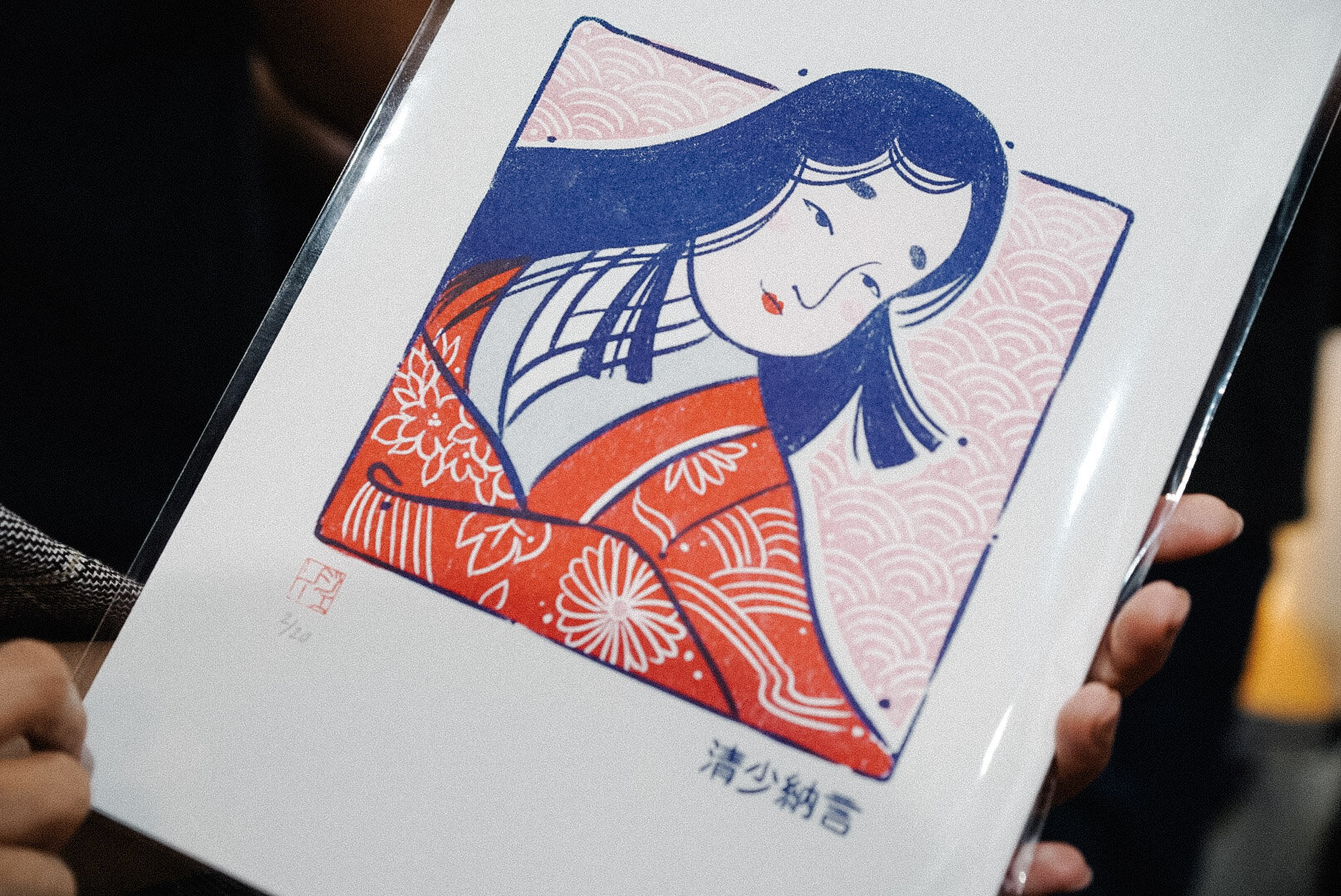 Image 1 of 5
Image 1 of 5

 Image 2 of 5
Image 2 of 5

 Image 3 of 5
Image 3 of 5

 Image 4 of 5
Image 4 of 5

 Image 5 of 5
Image 5 of 5






Princess Oyama Sutematsu 大山捨松 - A4 Riso Print (Signed and Numbered)
Princess Oyama Sutematsu 大山捨松
First Japanese woman to receive a degree
最初の学位を取った日本女性 (1860年3月16日-1919年2月18日)
当時、女性は日本の大学に通うことはできても学位を取ることは認められていませんでした。
Born Yamakawa Sakiko to a family in the Aizu samurai clan, she was present during the attack on Aizu castle during the Boshin Civil War. The Aizu clan were overwhelmed and surrendered unconditionally.
When Japan ended its 220-year-old policy of isolation and opened its borders to American trade in 1853, the government sought volunteers to go abroad on diplomatic missions to gain recognition and learn about the dominant world powers. Yamakawa’s brother signed her up to go to America against her will—a particularly harsh action given the fact that hardly any Japanese had ever gone abroad before.
In America, Yamakawa attended and graduated from Vassar College, making her the first Japanese woman to earn a degree. At the time, although women were allowed to attend university in Japan, they were not allowed to earn degrees. Upon returning to Japan, she married the Imperial Japanese Army general and later became Princess Oyama.
In 1885, she was requested to help set up the Peeresses’ School in Tokyo and eventually became its trustee. In 1900, she co-founded the Joshi Eigaku Juku (Girls’ School for English Studies) alongside her American friends to support the cause of women’s education in Japan.
What is a riso print?
These prints use risograph technology, a method of printing developed in Japan in the mid-1980s. It can be described as a mix between screenprinting and photocopying. The risograph process produces prints with extremely vibrant, crisp inks, and sometimes these inks overlap during the printing process to create interesting and unique details. These soy-based inks also have a lower environmental impact.
Product details
Printed in Tokyo, Japan by Hand Saw Press print studio. Each print is A4 size (210 x 297 mm / 8.27 x 11.69 in) and printed on Natural White 186gsm Takeo Araveal paper. Acid-free and FSC Approved.
Each print is signed with a traditional Japanese ‘hanko’ artist stamp and hand-numbered from a limited edition of 20. Prints are packaged in cello bags with rigid cardboard inserts and shipped in flat mailers.
Please note that frames are not included.
Delivery times & prices
We ship worldwide. 日本へ国際郵便で送ります。
UK deliveries: 3-4 working days via Royal Mail 1st class
International deliveries available via Royal Mail International Standard Airmail
Prices calculated during checkout
For more information on shipping times for international deliveries, please check the delivery & returns page.
Princess Oyama Sutematsu 大山捨松
First Japanese woman to receive a degree
最初の学位を取った日本女性 (1860年3月16日-1919年2月18日)
当時、女性は日本の大学に通うことはできても学位を取ることは認められていませんでした。
Born Yamakawa Sakiko to a family in the Aizu samurai clan, she was present during the attack on Aizu castle during the Boshin Civil War. The Aizu clan were overwhelmed and surrendered unconditionally.
When Japan ended its 220-year-old policy of isolation and opened its borders to American trade in 1853, the government sought volunteers to go abroad on diplomatic missions to gain recognition and learn about the dominant world powers. Yamakawa’s brother signed her up to go to America against her will—a particularly harsh action given the fact that hardly any Japanese had ever gone abroad before.
In America, Yamakawa attended and graduated from Vassar College, making her the first Japanese woman to earn a degree. At the time, although women were allowed to attend university in Japan, they were not allowed to earn degrees. Upon returning to Japan, she married the Imperial Japanese Army general and later became Princess Oyama.
In 1885, she was requested to help set up the Peeresses’ School in Tokyo and eventually became its trustee. In 1900, she co-founded the Joshi Eigaku Juku (Girls’ School for English Studies) alongside her American friends to support the cause of women’s education in Japan.
What is a riso print?
These prints use risograph technology, a method of printing developed in Japan in the mid-1980s. It can be described as a mix between screenprinting and photocopying. The risograph process produces prints with extremely vibrant, crisp inks, and sometimes these inks overlap during the printing process to create interesting and unique details. These soy-based inks also have a lower environmental impact.
Product details
Printed in Tokyo, Japan by Hand Saw Press print studio. Each print is A4 size (210 x 297 mm / 8.27 x 11.69 in) and printed on Natural White 186gsm Takeo Araveal paper. Acid-free and FSC Approved.
Each print is signed with a traditional Japanese ‘hanko’ artist stamp and hand-numbered from a limited edition of 20. Prints are packaged in cello bags with rigid cardboard inserts and shipped in flat mailers.
Please note that frames are not included.
Delivery times & prices
We ship worldwide. 日本へ国際郵便で送ります。
UK deliveries: 3-4 working days via Royal Mail 1st class
International deliveries available via Royal Mail International Standard Airmail
Prices calculated during checkout
For more information on shipping times for international deliveries, please check the delivery & returns page.
Princess Oyama Sutematsu 大山捨松
First Japanese woman to receive a degree
最初の学位を取った日本女性 (1860年3月16日-1919年2月18日)
当時、女性は日本の大学に通うことはできても学位を取ることは認められていませんでした。
Born Yamakawa Sakiko to a family in the Aizu samurai clan, she was present during the attack on Aizu castle during the Boshin Civil War. The Aizu clan were overwhelmed and surrendered unconditionally.
When Japan ended its 220-year-old policy of isolation and opened its borders to American trade in 1853, the government sought volunteers to go abroad on diplomatic missions to gain recognition and learn about the dominant world powers. Yamakawa’s brother signed her up to go to America against her will—a particularly harsh action given the fact that hardly any Japanese had ever gone abroad before.
In America, Yamakawa attended and graduated from Vassar College, making her the first Japanese woman to earn a degree. At the time, although women were allowed to attend university in Japan, they were not allowed to earn degrees. Upon returning to Japan, she married the Imperial Japanese Army general and later became Princess Oyama.
In 1885, she was requested to help set up the Peeresses’ School in Tokyo and eventually became its trustee. In 1900, she co-founded the Joshi Eigaku Juku (Girls’ School for English Studies) alongside her American friends to support the cause of women’s education in Japan.
What is a riso print?
These prints use risograph technology, a method of printing developed in Japan in the mid-1980s. It can be described as a mix between screenprinting and photocopying. The risograph process produces prints with extremely vibrant, crisp inks, and sometimes these inks overlap during the printing process to create interesting and unique details. These soy-based inks also have a lower environmental impact.
Product details
Printed in Tokyo, Japan by Hand Saw Press print studio. Each print is A4 size (210 x 297 mm / 8.27 x 11.69 in) and printed on Natural White 186gsm Takeo Araveal paper. Acid-free and FSC Approved.
Each print is signed with a traditional Japanese ‘hanko’ artist stamp and hand-numbered from a limited edition of 20. Prints are packaged in cello bags with rigid cardboard inserts and shipped in flat mailers.
Please note that frames are not included.
Delivery times & prices
We ship worldwide. 日本へ国際郵便で送ります。
UK deliveries: 3-4 working days via Royal Mail 1st class
International deliveries available via Royal Mail International Standard Airmail
Prices calculated during checkout
For more information on shipping times for international deliveries, please check the delivery & returns page.



